Table of Contents
How to Start a Campfire Without Matches
Sitting around a crackling campfire under the stars is one of life’s simple pleasures. The glowing flames provide warmth, light, and ambience for cooking, conversations, or just contemplating the beauty of nature. But what if you arrive at your campsite only to realize you forgot to pack matches or a lighter? Don’t despair – you can still start a fire without modern fire starters.

In this post, I’ll share 7 straightforward methods for starting a campfire using natural and primitive techniques. With a bit of preparation and know-how, you can harness the elements to create fire through friction, sparks, focused sunlight, and more. Let’s dive in and learn how to unleash your inner survivalist!
Gather Tinder, Kindling, and Fuel
Before attempting to ignite your campfire, it’s crucial to gather all the materials you’ll need for the fire to catch and sustain itself. I like to collect everything I need before beginning so that I have it all within reach. Here are the three key components:
- Tinder – Very fine, dry material that ignites easily with a spark or small flame. Good options include grass, leaves, bark, twigs, wood shavings, lint, or even paper.
- Kindling – Slightly larger dry sticks, twigs, and woody biomass that will catch fire from the flaming tinder. Move up to pencil-width and finger-width sticks.
- Fuel – Larger dry logs, branches, and chopped firewood to keep the fire burning long-term once the kindling has caught flame. Use a mix of log sizes.
Make sure everything is bone dry. Look for dead/downed wood rather than green branches. Gather way more than you think you’ll need, as you may have to rebuild the fire stack multiple times while perfecting your starting technique.
Method 1: Flint and Steel
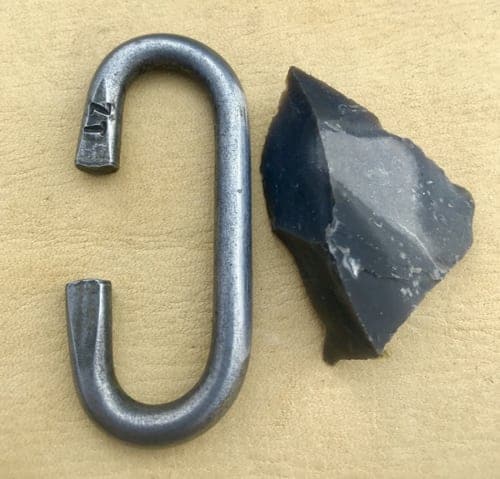
One of the most reliable non-match methods is generating sparks with flint and steel. Strike pieces of flint rapidly against high-carbon steel to create hot sparks that will ignite your tinder. Here’s how:
What You’ll Need
- Flint stone or quartz
- Carbon steel striker or knife
- Tinder material
Steps
- Prepare your tinder by breaking it down into a nest-like pile for catching sparks. Good options are charred cloth, bird nest fluff, or shaved bark.
- Hold the steel striker at about a 45° angle just above the tinder nest.
- Strike the flint or quartz against the steel forcefully in quick strokes. This shaves off tiny steel particles that ignite in the air from friction.
- Once the tinder begins smoldering, gently blow on it to feed oxygen and coax the glowing embers into flame.
- Gradually add kindling as the fire grows. Stack on fuel logs once you have a healthy campfire blazing.
With practice, flint and steel is incredibly reliable. Just takes some work! For best results, look for high-carbon steel (over 0.6% carbon content).
Method 2: Fire Plough
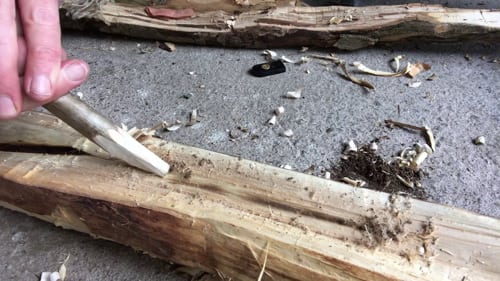
The fire plough method involves cutting a v-shaped groove into a piece of dry softwood, then vigorously rubbing a stick up and down the groove to generate friction heat and sawdust that will ignite. Here’s how it works:
What You’ll Need
- Softwood baseboard – cedar, cypress, juniper, pine, spruce etc.
- Plough stick – harder wood like oak, maple, birch
- Tinder material
Steps
- Carve a v-shaped groove into the softwood base, at least 1/2 inch deep.
- Prepare your tinder bundle and set it at the end of the groove to catch embers.
- Take your plough stick and rub it forcefully up and down the length of the groove at a fast pace.
- Once smoke appears, start blowing air into the groove to feed oxygen to the heated wood dust.
- When the tinder ignites, transfer it gently to your fire lay and add kindling.
It can take 15-30 minutes of vigorous rubbing to master this technique. But with practice you’ll get an intuitive feel for the needed speed and pressure. This method has started fires for centuries!
Method 3: Hand Drill
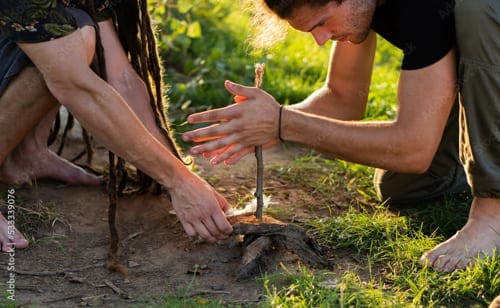
The hand drill technique also relies on friction heat from rubbing wood together. But instead of a grooved plank, you’ll be spinning a stick rapidly against a flat wood base to generate sawdust that ignites. It requires coordination and persistence, but works reliably once you get the hang of it.
What You’ll Need
- 1/2″-3/4″ drill stick – softwood like cedar, cypress, pine, or poplar
- Fire board – quartersawn hardwood like oak, maple, or birch
- Tinder material
- Socket stone or wood block (optional)
Steps
- Carve a shallow depression in the center of the fire board. Shape the drill tip so it nests snugly in this groove.
- Prepare your tinder bundle and place it under the fire board, near the edge.
- Kneel with one foot gently on the fire board for stability.
- Rapidly roll the drill stick between your palms, applying downward pressure. Work up a momentum from short strokes to long spins.
- Once smoke appears, fan air into the groove and continue spinning until the tinder ignites.
- Transfer the tinder to your fire lay and gently blow until the kindling catches.
The hand drill method takes practice, as friction needs to be continuous. Have water on hand to lubricate and cool the drill tip. Once you get the technique dialed in, this simple tool is unbeatable.
Method 4: Bow Drill
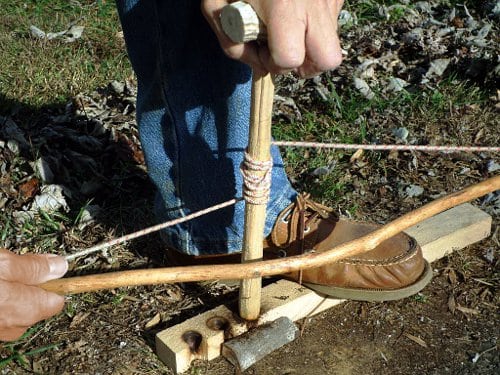
Similar to the hand drill, the bow drill uses friction between a spinning stick and fire board. But instead of spinning it between your hands, you’ll use a bow to rotate the drill, allowing you to create longer and more continuous spins.
What You’ll Need
- 3/4″-1″ drill stick – poplar, cedar, willow, or cypress work well
- Fire board – oak, maple, elm, hickory, or walnut
- Bow – green, flexible wood
- Tinder
Steps
- Carve a socket depression into your fire board, then shape the drill tip to fit.
- Cut a bow from green wood and tie the drill securely to the bow.
- Place one foot on the fire board for stability.
- Draw the bow back and forth to spin the drill in the socket. Apply downward pressure.
- Once smoke appears, start blowing air into the groove while continuing to saw back and forth.
- When tinder ignites, transfer to your fire structure and proceed as normal.
The key to success is finding your rhythm and maintaining continuous, fast rotation of the drill. The bow allows you to spin for longer periods, creating superior friction heat. With some perseverance, you’ll be a fire starting pro.
Method 5: Lens and Sunlight
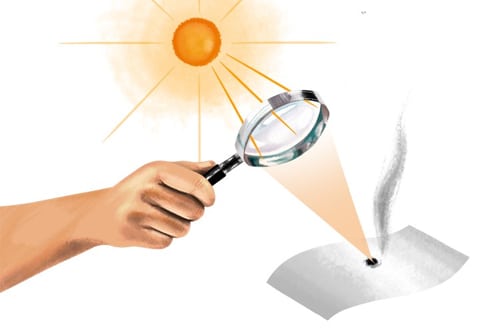
Harnessing the sun’s power can also get your campfire going without matches. Using a lens to concentrate and intensify sunlight into a single spot will produce enough heat to ignite tinder. Here’s how to do it:
What You’ll Need
- Convex lens – eyeglasses, magnifying glass, binoculars, camera lens, or telescope eyepiece
- Tinder material
- Bright, sunny day
Steps
- Prepare your tinder bundle – charcloth and bird nest fluff work well.
- Angle your lens toward the sun until a bright focal point appears on the tinder.
- Gently blow on the smoking tinder spot while continuing to focus sunlight through the lens.
- Once the tinder ignites, add kindling to build the flame.
The advantage of this method is that it requires no physical effort – just the warmth of the sun’s rays. But you need optimal weather conditions and a high quality lens. When the conditions align, this technique quickly starts a fire using just mother nature’s light.
Method 6: Batteries and Steel Wool
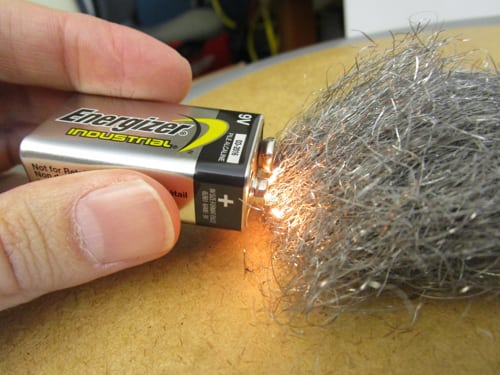
Fine steel or brass wool can ignite easily with a small electrical current from a battery. When live current is applied, the metal filaments heat up quickly and begin glowing, creating a hot ember.
What You’ll Need
- 0000 grade (very fine) steel or brass wool
- 9v battery
- Tinder material
Steps
- Lightly tease and fluff the steel wool into a nest shape, about the size of your palm.
- Connect the battery terminals to the steel wool – it may spark and begin glowing immediately.
- If not glowing, touch the steel wool with your knife tip to draw an arc of brighter current across the strands.
- Once glowing, place the steel wool into your tinder bundle and gently blow air on it.
- When the tinder ignites, safely remove the battery and build up your fire as normal.
This method won’t drain your battery much at all. The wire filaments create resistance and heat up quickly. Just be cautious when first connecting to avoid getting burned by flying sparks.
Method 7: Compressed Air
Rapidly compressing air into a confined space can produce enough heat through friction to ignite tinder. While kits are available, you can improvise the components with common items.
What You’ll Need
- Air compressor – bicycle pump, vehicle A/C pump, etc.
- Pressure chamber – pen or tube with tight-fitting plunger or piston
- Tinder material
Steps
- Prepare a fine tinder bundle and place it in your pressure chamber.
- Rapidly compress air into the chamber using short, forceful strokes.
- Once the tinder begins smoldering, transfer it to your fire lay and blow gently to ignite.
- Build up the fire as the tinder’s flame spreads to kindling.
The adiabatic compression heats the interior air mass rapidly. Smaller chambers require less stroke volume to achieve ignition. This method may take some tinkering but can work in a pinch if you’re creative.
Conclusion
Starting a campfire without matches requires clever use of natural resources and physics. With practice, techniques like flint and steel, friction drills, lenses, and compressed air will have your camp blazing in no time. Know your limitations and stay safe – always keep water on hand to manage an accidental wildfire.
Once you master various primitive fire-starting methods, you’ll take confidence in your outdoor skills to the next level. A roaring campfire built with your own hands and ingenuity makes for an incredibly rewarding experience. Ignite that primal connection to nature, and let your inner survivalist shine!
FAQs
Which tinder materials work best for non-match fires?
A: Fine, dry tinder like charred cloth, jute, bird nest fluff, grass, bark fuzz, and wood shavings are excellent for catching sparks and embers to grow a flame.
Can I start a fire by rubbing two sticks together?
A: Yes, with persistence and proper technique you can absolutely ignite tinder through friction using the hand drill or bow drill method. Use softwood for the drill and hardwood for the fireboard.
How long does it take to start a fire without matches?
A: With practice, skilled survivalists can start brisk fires in under a minute using flint and steel. Friction methods take more time – typically 5-15 minutes of continuous spinning using bow or hand drill techniques.
Is it possible to start a fire just by focusing sunlight?
A: Yes! Using a convex lens to concentrate sunlight into a tight beam can generate enough heat to ignite dry tinder when conditions are optimal. Magnifying glasses, eyeglasses, or binoculars can all work.
What are some shoulder season and winter options for non-match fires?
A: Chemical heaters, flint & steel on charcloth, high-carbide steels striking quartzite, and magnifying sunlight on dark kindling are all reliable options when wood is damp or snowy.
Do survival fire starting kits actually work well?
A: High quality kits with flint, steel, and waterproof tinder can be very effective. But with practice, homemade friction tools and gathered tinder work just as well. Kits are convenient but not essential.
How can I avoid getting burned while learning primitive fire lighting?
A: Keep water nearby to douse accidental flames. Wear gloves when handling hot materials like coals. Angle blowing to avoid backdrafts. Master tinder ignition before adding kindling to a new method.

